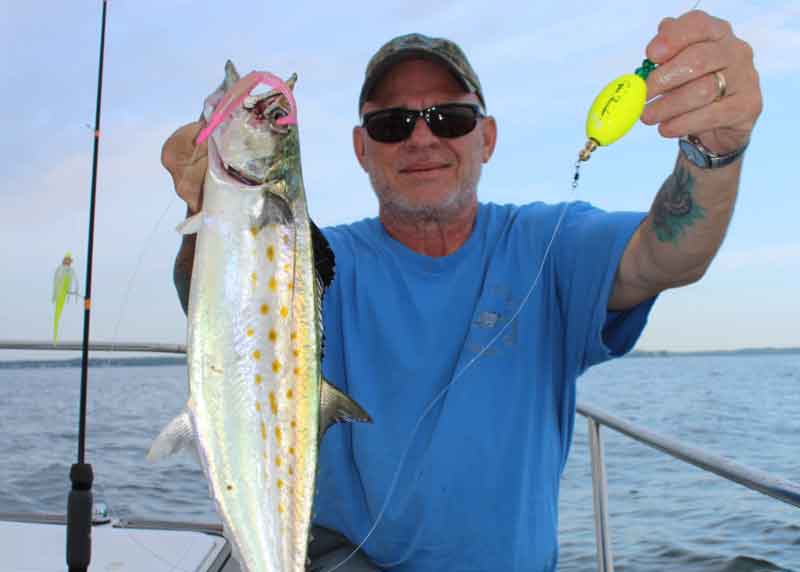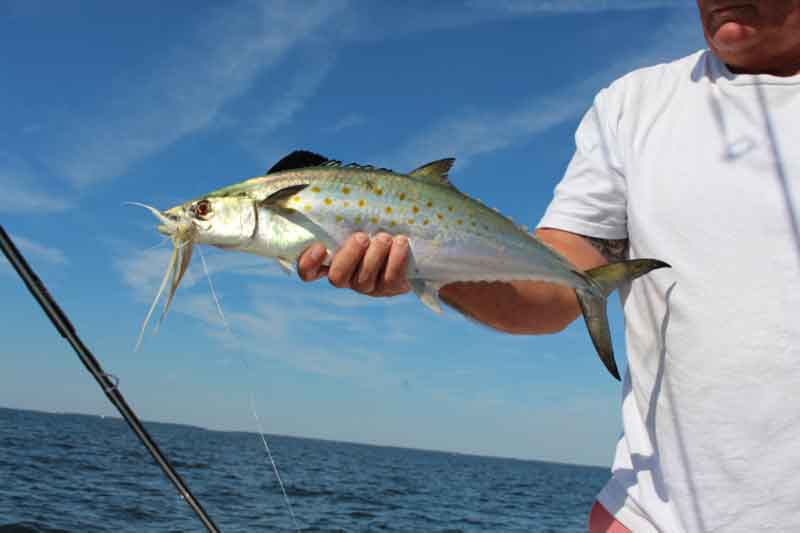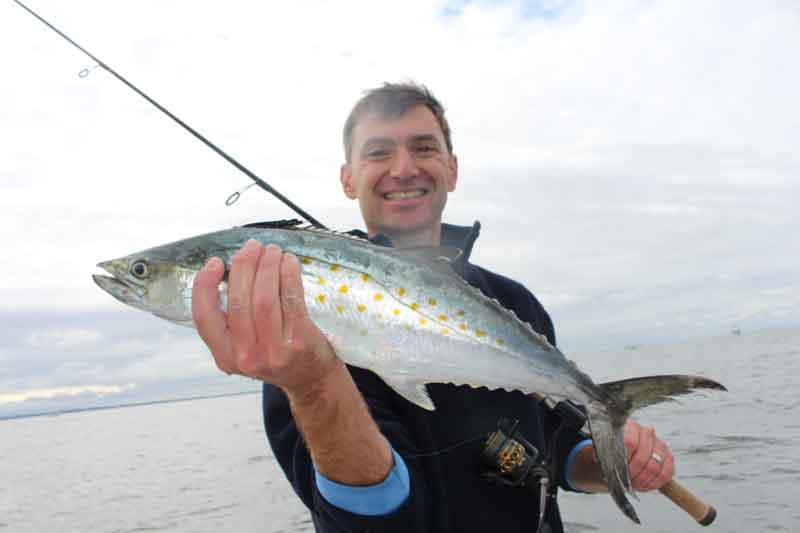Truth: the most effective way to stack Spanish mackerel into a fishbox is trolling for them with planers and spoons. Another truth: this can get thoroughly boring, even when the bite is good, as Spanish mackerel are relatively small fish and half the time “fighting” them to the boat on trolling gear is akin to winching your boat onto the trailer. But fishing for Spanish mackerel doesn’t have to be that way.

Light Tackle Spanish Mackerel
Fighting macks on light spinning or conventional gear in the 12- to 17-pound class, on the other hand, is one heck of a lot of fun. And plenty of anglers indulge in the experience when hordes of fish ball up and break water, attracting flocks of birds. The standard procedure: Drive your boat into an upwind or up-current position, cast a two- to three-inch spoon directly into the fray, and crank it back post haste. So… just how fast should you crank?
Those of you who’ve trolled for mackerel know that seven to nine mph is often the optimal speed range. Yet with an average spinning reel, it’s quite difficult to get a lure moving faster than six mph. When doing research for an article in the past we measured out a small fraction of a mile, timed how long it took to crank a casting plug from point A to point B (with a Penn 440ssg), and crunched the numbers. A slow retrieve was between 1.5 and 2.0 mpg, a moderate retrieve was in the 3.0 to 4.0 range, and whipping the crank around as hard and fast as possible we were barely able to nick 6.4 mph. Thus, finding the correct retrieval speed when going for mackerel is really quite simple: reel as fast as you can, period — and it still won’t be fast enough.

Good spoons to offer include those with enough weight to result in long casts: Slim Jims, Kastmasters, and the like. You can also use trolling spoons like Drones but will need to add an ounce or so in-line a couple of feet ahead of the spoon, or your casting distance will be cut short.
Unconventional Mackerel Fishing
Last season I was exposed to a new method of light tackle casting for Spanish mackerel, which I doubted at first but proved to out-fish the spoons: popping cork rigs. I was fishing with the kind folks from Hard Head Custom Baits, when we saw a mackerel greyhounding nearby they whipped out their rigs with red and chartreuse popping corks a few feet above a four-inch plastic paddle-tail (pinks were best) on a half-ounce jighead. Cast out and then chugged quickly back towards the boat with short, abrupt jerks on the rod tip, the mackerel were wild for ‘em (as were the stripers and blues, BTW).
While they casted the popping corks I tossed my spoon, and by my estimation the cork rigs did about 50-percent better. Particularly interesting was the fact that when mackerel hit the jigs under the corks they rarely missed the hook, while missed strikes and/or pulled hooks on the spoon, with its small treble hook, were common. In fact, I’m not convinced that the cork rigs drew any more strikes than the spoons — but I am convinced that they resulted in putting more fish in the boat.
Looking Sharp
Of course, you can’t always order up a flock of birds and a school of breaking fish. If you’ve been reading FishTalk for a while, you’ve probably heard me say this before: when it comes to finding breaking fish, the best weapon in your arsenal is a good pair of gyroscopic-stabilized binoculars. Those with 14X or more magnification are best. I’m a big fan of the Fujinon 14 X 40 Techno-Stabi binocs, which are built like a tank and have a wider range of stabilization than most. Why do I like them so much? I’ve spotted minor-league flocks of just a dozen or so birds and then run to them and measured the distance, on GPS, at over seven miles. With the bare eye you’ll be lucky to spot that many birds at a mile. With regular 7X marine binoculars, you might get to three miles on a calm day. And while radar can help at times, there are often so dang many people out on the Bay that you find yourself chasing boats rather than birds. So I say bite the bullet, spend the big bucks (a little over a grand) and get the gyro-binocs.
ISO Spanish Macks
What do you do, when you get out into the middle of the Bay but can’t find any feathered friends regardless of the tools at your disposal? As a general rule of thumb, it’s a good idea to pick a course or destination, run a couple-few more miles at a time, stopping and spying through the glasses as you go. And when doing so, also look for birds sitting on the water. Five or six aren’t usually worth checking out, but a dozen or more indicate that something was happening in the area not too long ago. So make a few ever-widening circles around the birds, and keep an eye on the meter. Then stop and pull out the binocs again. Make another wide circle (as wide as a quarter mile or so). If you detect nothing, mark the spot on your chartplotter so you can check the area again later when you’re heading back home. By then maybe the tide will have changed or for whatever reason, fish in the area will have kicked into high gear.

Another thing you’ll want to be aware of as you cruise around looking for birds are underwater points and edges that abruptly go from 15-ish feet of water to 25-plus or more. Sometimes you’ll find mackerel meandering up and down edges like this where the current hits and bait gathers. True, Spanish mackerel are open-water fish and most of the time they’re focused on schools of bait as opposed to structure. But where and when the structure funnels the bait, the mackerel may concentrate.
The Last Resort
Now let’s say you’ve cruised as far as you’re willing and you still haven’t found squat. What to try next? Grab the trolling rods you stowed aboard just in case, and deploy those planers and spoons. Then when you catch a mackerel or two, stick to the area and keep the light gear ready. Where there’s one there’s usually a whole lot more, and chances are that sooner or later the school will push bait up top, you’ll see swirls or birds, and you’ll be able to crank in that trolling gear, stow it, and start tossing the light stuff. With a little luck, it’ll happen before you get bored to tears.
For more mackerel tips including various fishing methods, check out How to Target Spanish Mackerel.